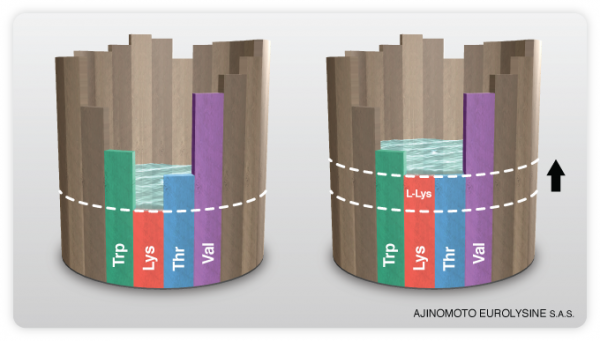Front View Feeds is excited to begin a blog on our website featuring articles about poultry feeding, nutrition, genetics, and general management to help you be successful with your flock. It is our goal to bring you the latest scientific research and data and help you to apply it to your flock so that you can be more successful. Whether you just own a few laying hens or are a serious breeder and no matter your experience level, we hope you can learn something from us.
To begin our blog, I would like to take time to discuss the role of protein in poultry diets. Having grown up in the exhibition poultry world and in discussions with other poultry breeders the most discussed nutrient is usually protein.
But what is protein? Why do people pay so much attention to it?
Proteins, known as “crude protein” in feed analysis, are nitrogenous compounds made up of individual amino acids. When these individual amino acids form bonds it produces a protein. Animals ingest this protein and the body breaks it down into the component amino acids during digestion. These amino acids are then metabolized by the animal to be used in tissue growth and repair. For example, a young growing chicken will use these amino acids for muscle hypertrophy (growth) or a racing pigeon will use amino acids to repair tissue after a long flight.
There are about 20 amino acids that are identifiable in animal tissue and are needed for various metabolic functions. Many of these amino acids can be synthesized by the animal itself and are considered “non-essential” amino acids. However, there are 10 amino acids that are considered to be “essential” meaning that the animal cannot synthesize them from other amino acids and must be present in the animal’s diet. These amino acids are the real reason that makes protein in a diet so important. Furthermore, the correct amino acids need to be present and in the right proportions. Depending on the species and age, these amino acid requirements change. Crude protein by itself, without knowing the amino acid composition, may or may not meet the specific amino acid requirement of the animal. This is why Front View Feeds balances all of its diets for amino acids, rather than just providing crude protein.
 A good way to visualize this concept of amino acid balancing is by thinking of the staves of a barrel, with each stave as one amino acid and the whole barrel as the protein. Water will only be able to fill up to the shortest stave, or the amino acid that is lacking the most, limiting the amount of water in the barrel, regardless of how high the other staves are.
A good way to visualize this concept of amino acid balancing is by thinking of the staves of a barrel, with each stave as one amino acid and the whole barrel as the protein. Water will only be able to fill up to the shortest stave, or the amino acid that is lacking the most, limiting the amount of water in the barrel, regardless of how high the other staves are.
So which amino acids are important?
In a typical corn/soy based poultry diet the first three limiting amino acids are as follows: methionine, lysine, and threonine. Methionine combined with Cysteine are the two sulfur containing amino acids and have a sparing effect on each other. In other words, cysteine can “substitute” methionine if it is lacking and vice versa. So really, this combination of methionine and cysteine is the first limiting amino acid.
Now going back to our barrel example, imagine that methionine + cysteine is lacking and is the shortest stave. That means that growth (water) will only be as high as the shortest stave (methionine + cysteine) allows. In other words, a diet can contain 30% crude protein but if the methionine + cysteine level is too low, growth will still be limited. The remainder of the crude protein present in the diet will most likely be excreted as nitrogen and wasted.
How do we account for this and ensure our diets contain these amino acids?
Historically, before amino acids had been studied much, nutritionists added high amounts of protein and protein from several ingredients since this is what gave better results. Now that we know much more about the importance of amino acids and can readily identify them in our feed ingredients, we can safely use less crude protein without negatively impacting bird performance.
Therefore to ensure that Front View diets contain enough amino acids we first analyze our ingredients. Most every ingredient we use contains these amino acids to some degree. By doing a regular analysis of our ingredients we know what we are feeding and these amino acids values are considered while formulating our diets. Ingredients such as soybean meal, pork meat and bone meal, and corn distiller’s dried grain with solubles (DDGS) are all high in amino acids. However, these alone usually aren’t enough to reach the amino acid requirement so we utilize synthetic methionine, lysine, and threonine. These synthetic amino acids are highly digestible and can be included at a very low rate to achieve our goal.
Now, this does not mean that crude protein values are not important at all, or that the first three limiting amino acids are the only important ones. Crude protein still needs be present, because of those seven other essential amino acids that we did not mention. But by formulating to amino acid requirements, rather than just crude protein, we can reduce the amount of crude protein in our diets. Which can have several benefits including:
- Reduced nitrogen waste: as mentioned above, excess nitrogen is wasted since amino acids can’t be stored by the body. So if we reduce total protein in the diet, less will be excreted. Which is a good thing because it is the nitrogen in uric acid that reacts with water in the environment and causes ammonia production. Excess ammonia can lead to a multitude of health problems for your flock.
- Reduce body heat production: Protein metabolism produces more heat than any other nutrient. By reducing body heat production we can reduce stress on the birds, especially during hot weather.
- Reduce water intake: Protein metabolism also requires the most water. When animals consume more water, more water is then excreted via urine, or uric acid in birds, which can then lead to wet litter and ammonia production.
- Improve fertility: Studies have shown that low crude protein diets actually improve the fertility of birds and conception rates in mammals.
- Reduced costs: pound for pound, protein is the most expensive nutrient. By reducing crude protein, we can reduce cost of the final product.
So to conclude our first blog post, yes protein is important for growth and tissue repair and adequate levels are needed for optimum performance. However, protein really isn’t as important as knowing the amino acid levels of a given diet. It is these amino acids that determine the potential for growth and performance. And due to this fact, we can safely lower crude protein levels which has many benefits for you and your flock. These are many of the reasons why a lot of Front View diets are relatively low in crude protein, especially diets for mature birds. This is also why many diets have the same or similar crude protein levels across different species. The amino acid requirements are different for each species and that is one of the reasons why we offer so many feed options.
We hope you learned something here and stay tuned for more information!
Michael
